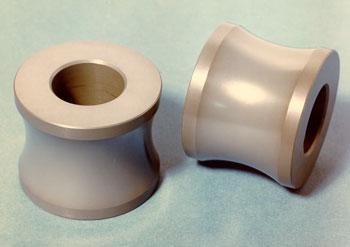|
The SiAlONs were developed as a more economic alternative to hot pressed silicon nitride.
.jpg)
Image Credits: shutterstock.com/Domagoj Burilovic
SiAlONs have a complex chemistry and should be thought of as a family of alloys with a wide range of properties. They are formed when silicon nitride (Si3N4), aluminium oxide (Al2O3) and aluminium nitride (AlN) are reacted together. The materials combine over a wide compositional range.
Fully dense polycrystalline bodies can be formed by pressureless sintering if sintering aids such as yttrium oxide are added to the compact. This innovation allows near net complex shaped components made at an economic cost. The most commonly used compositions at present are β-SiAlON and (α + β) SiAlONs, which contain a substantial excess of sintering aids. However, the field is still changing with compositions developing to suit specific applications.
|
Key Properties
|
|
SiAlONs exploit the following properties:
- low density
- high strength
- superior thermal shock resistance
- moderate wear resistance
- fracture toughness
- mechanical fatigue and creep resistance
- oxidation resistance
In pressureless sintered materials, the high temperature properties are limited by the glassy phases that form at grain boundaries during sintering. These materials are only suitable to long term use at temperatures of less than 1000°C. Typical properties are outlined in table 1.
Table 1. Typical Physical and Mechanical Properties of SiAlON (Syalon 501)
|
|
|
Density (g.cm-3)
|
4.01
|
|
Young’s Modulus (GPa)
|
340
|
|
Bend Strength (MPa)
|
825
|
|
Fracture Toughness K1c (MPa.m 0.5)
|
5.7
|
|
Hardness, (GPa)
|
13.24
|
|
Thermal Expansion Coefficient (x 10-6/°C)
|
5.6
|
|
Thermal Conductivity (W/m.K)
|
19
|
|
Maximum Operating Temperature (°C)
|
700
|
Properties may vary widely as the family of materials known as SiAlONs covers a vast compositional range.
|
Applications
|
|
As with other silicon nitride based ceramics, SiAlONs are used currently in niche market applications for example in:
Cutting Tools
The hot hardness, fracture toughness and thermal shock resistance of fully dense SiAlON makes it well suited to use in cutting tools. The material is an attractive low cost alternative to hot pressed silicon nitride for machining grey cast iron for automotive applications. The material gives both increased metal removal rate and longer tool life compared with conventional cutting tools.
SiAlONs have also replaced cemented carbide tools when machining nickel based superalloys. These alloys are used for their heat resistance or in aerospace applications and are notoriously difficult to machine. Pressureless sintered SiAlON can also increase tool life by up to 10 times in comparison with silicon nitride tools when machining these alloys.
Wear Components
Wear components exploit the electrical insulation, low thermal conductivity, and wear and thermal shock resistance of the material. Representative wear applications are fixtures for positioning and transferring metal parts during processes such as induction heating or resistance welding (see figure 1). For example, SiAlON has been used to make location pins when resistance welding automotive components. The conventional hardened steel pin with an alumina sleeve lasted 8 hours, whilst the SiAlON pin lasted one year.
|

|
|
Figure 1. SiAlON wear guides (photo courtesy International Syalons Newcastle Ltd).
|
Metal Forming Tools
SiAlONs have been used in metal wire and tube drawing tools for non-ferrous metals such as copper and aluminium alloys. In general the hardness, low coefficient of friction and lack of adhesion and reaction have given good results. High levels of copper oxide in copper alloys must be avoided however, as it attacks the material and tolerance control is lost.
Other Applications
SiAlONs are also used for other applications such as seals and bearings.
|

|
|
Figure 2. A selection of SiAlON seals and bearings (photo courtesy International Syalons Newcastle Ltd).
|
|
|
|
.jpg)
This information has been sourced, reviewed and adapted from materials provided by Internatrional Syalons.
For more information on this source, please visit International Syalons.